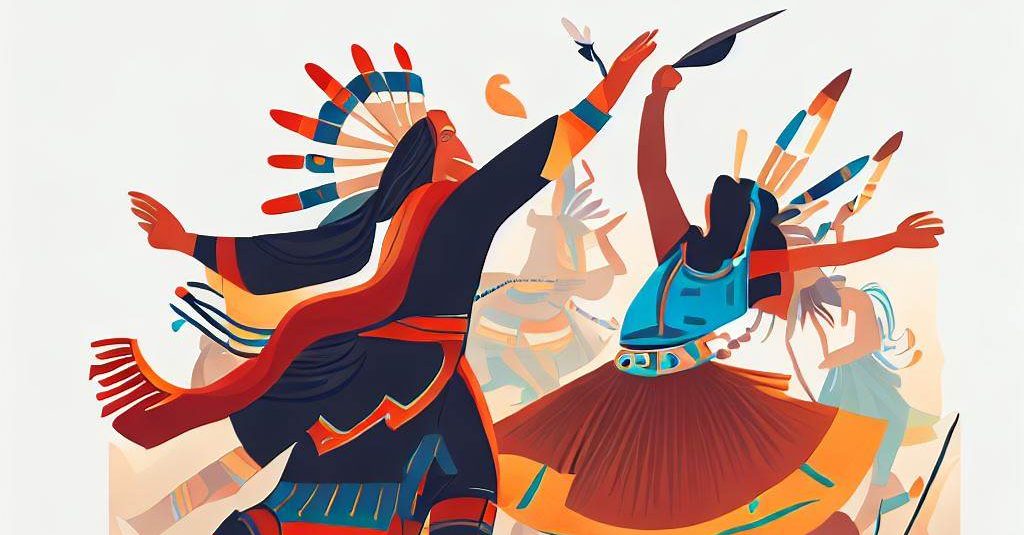Traditional Navajo Ceremonies: An Exploration of Cultural Significance and Interconnectedness
The Navajo people, known as Diné in their own language, have a rich and diverse history of traditional ceremonies that serve as a cornerstone of their cultural and spiritual identity. Navajo ceremonies, known as “chants” or “sings,” serve various purposes such as healing, protection, blessings, and rites of passage. This article will explore the cultural significance and interconnectedness of Navajo ceremonies, offering insight into the spiritual lives of the Navajo people and their relationships with other Native American tribes.
Navajo Ceremonial System
Navajo ceremonies are complex and multifaceted, encompassing a vast array of ritual elements such as prayer, song, dance, sandpainting, and the use of sacred objects. The Navajo believe that these ceremonies help restore and maintain harmony (Hózhǫ́) within the individual, the community, and the natural world by invoking the power and guidance of the Holy People (Diyin Diné’é).
There are numerous Navajo ceremonies, with some sources suggesting over 50 different types. These ceremonies can be broadly categorized into two main groups: Blessingway ceremonies and Enemyway ceremonies.
Blessingway Ceremonies
Blessingway ceremonies (Hózhǫ́ǫ́jí) focus on promoting harmony, balance, and well-being within the individual and the community. These ceremonies often celebrate important life events such as births, marriages, and coming-of-age rituals. The Blessingway is considered the foundation of all Navajo ceremonies and is thought to encompass the principles of Hózhǫ́.
Some examples of Blessingway ceremonies include:
- Kinaaldá: The Kinaaldá ceremony is a coming-of-age ritual for young Navajo women, marking their transition from childhood to womanhood. The ceremony involves various ritual activities, such as molding the girl’s body to resemble Changing Woman, a revered Navajo deity. The girl also participates in a footrace to symbolize her strength and vitality as she enters adulthood.
- Wedding Ceremony: The Navajo wedding ceremony is a ritual that unites a couple in marriage. The ceremony includes the exchange of cornmeal, symbolizing the couple’s commitment to support and care for each other. The couple also receives blessings from their families and community members, ensuring a harmonious and prosperous union.
- Baby Blessing Ceremony: This ceremony is performed shortly after the birth of a child to bless the newborn and welcome them into the community. The baby’s umbilical cord is often buried near the family’s home, symbolizing the child’s connection to their ancestral land and community.
- House Blessing Ceremony: When a new home is constructed, a house blessing ceremony is performed to cleanse and protect the dwelling. The ceremony includes prayers and songs, as well as offerings of cornmeal and pollen to invite positive energy and harmony into the space.
- Protection and Purification Ceremony: This ceremony aims to cleanse an individual or a family of any negative influences or harmful energies. The ritual involves the use of sacred herbs, such as sage and cedar, to purify the space and the people involved. Prayers and songs are also used to invoke the protection and guidance of the Holy People.
- Harvest Blessing Ceremony: The harvest blessing ceremony is performed to give thanks for a successful crop and to ask for continued abundance in the coming seasons. The ceremony includes offerings of corn, beans, squash, and other crops to the Holy People, as well as prayers and songs of gratitude and blessings.
Enemyway Ceremonies
Enemyway ceremonies (‘Ánáá’jí) are focused on protection and healing from various types of harm, including illness, witchcraft, and contact with the spirits of the dead. The Enemyway is also used to help reintegrate veterans into the community after returning from war.
Examples of Enemyway ceremonies include:
- Protection and Healing Ceremony: This ceremony aims to cleanse and heal an individual who has been exposed to harmful energies or influences, such as contact with the spirits of the dead, accidents, or other traumatic events. The ritual involves the use of sacred herbs, such as sage and cedar, to purify the person and their surroundings. Prayers, chants, and songs are also used to invoke the protection and guidance of the Holy People and to drive away malevolent forces.
- Warrior Ceremony: The Warrior Ceremony is performed to help veterans who have returned from war or conflict to reintegrate into the community and to cleanse them of any harmful energies or traumas associated with their experiences. The ceremony includes prayers, songs, and dances to honor the warrior’s bravery and to help them reconnect with their cultural identity and spiritual well-being.
- Ghostway Ceremony: The Ghostway ceremony is a healing ritual that aims to protect an individual from harmful influences associated with contact with the spirits of the dead. The ceremony involves the creation of sand paintings, which depict the Holy People and other sacred imagery, to help guide and protect the afflicted individual. Prayers, songs, and dances are also performed to cleanse the person and their environment of any negative energies.
- Bearway Ceremony: The Bearway ceremony is a healing ritual that addresses illnesses or ailments caused by contact with the bear or its spirit. The ceremony involves the creation of sand paintings, which depict the Holy People and the bear in various forms, to help guide and protect the afflicted individual. Prayers, songs, and dances are also performed to cleanse the person and their environment of any negative influences associated with the bear.
- Chiricahua Windway Ceremony: The Chiricahua Windway ceremony is a healing ritual that addresses illnesses or ailments caused by the Chiricahua Apache spirits or other malevolent forces. The ceremony involves the creation of sand paintings, which depict the Holy People and the Chiricahua Apache spirits, to help guide and protect the afflicted individual. Prayers, songs, and dances are also performed to cleanse the person and their environment of any negative influences.
Interconnectedness with Other Native American Tribes
Navajo ceremonies exhibit connections with other Native American tribes, reflecting a shared history and cultural exchange. One such connection is the influence of Puebloan traditional practices on Navajo ceremonies.
The Navajo people adopted and adapted various elements of Puebloan ceremonial practices, including the use of ritual objects like prayer sticks, fetishes, and pottery. The Navajo also adopted some Puebloan traditional beliefs, such as the concept of kachinas (supernatural beings who serve as intermediaries between the human and spiritual realms).
In addition to the Pueblo influence, Navajo ceremonies share some similarities with the rituals and beliefs of other neighboring tribes, such as the Apache and Ute. This interconnectedness highlights the importance of cultural exchange and mutual understanding among Native American tribes.
Preservation and Continuity of Navajo Ceremonies
Navajo ceremonies have faced challenges in the form of cultural assimilation and suppression by outside forces, particularly during the period of Indian boarding schools and the imposition of Christianity. Despite these challenges, traditional ceremonies have persevered and remain an essential part of the cultural and spiritual life of the Navajo people.
Efforts have been made to preserve and transmit traditional Navajo ceremonial knowledge, including the work of anthropologists, linguists, and Navajo cultural practitioners. These efforts have resulted in the documentation and recording of ceremonies, as well as the establishment of cultural centers and educational programs aimed at revitalizing and maintaining Navajo ceremonial practices.
One notable example of preservation efforts is the Navajo Nation Museum in Window Rock, Arizona, which serves as a cultural center and repository for Navajo history, art, and ceremonial knowledge. The museum hosts workshops, exhibitions, and educational programs designed to promote understanding and appreciation of Navajo culture, including religious ceremonies.
Moreover, the continued practice of Navajo ceremonies within the community ensures their transmission to future generations. Elders and medicine people play a crucial role in passing on their knowledge and expertise to younger community members, ensuring the continuity and vitality of Navajo religious traditions.
Conclusion
Navajo religious ceremonies provide a window into the spiritual lives and cultural identity of the Navajo people. These ceremonies, deeply rooted in the principles of Hózhǫ́, serve to maintain harmony and balance within the individual, the community, and the natural world. The interconnectedness of Navajo ceremonies with those of other Native American tribes highlights the importance of cultural exchange and understanding in fostering a greater appreciation of indigenous histories, cultures, and experiences.
Despite the challenges faced throughout history, Navajo religious ceremonies continue to thrive as an essential aspect of Navajo culture. Through preservation efforts and the ongoing practice of these ceremonies within the community, the Navajo people ensure the transmission of their spiritual heritage to future generations.
Key Sources Consulted:
- Faris, James C. “The Nightway: A History and a History of Documentation of a Navajo Ceremonial.” University of New Mexico Press, 1990.
- Kluckhohn, Clyde, and Dorothea Leighton. “The Navajo.” Harvard University Press, 1946.
- McNeley, James Kale. “Holy Wind in Navajo Philosophy.” University of Arizona Press, 1981.
- Reichard, Gladys A. “Navajo Medicine Man: Sandpaintings and Legends of Miguelito.” Dover Publications, 1990.
- Witherspoon, Gary. “Navajo Kinship and Marriage.” University of Chicago Press, 1975.
- Wyman, Leland C. “Blessingway: With Three Versions of the Myth Recorded and Translated from the Navajo by Father Berard Haile, O.F.M.” University of Arizona Press, 1970.

